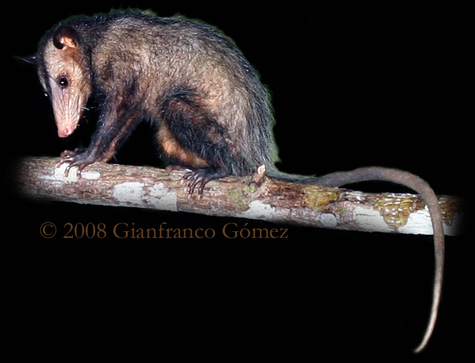|

The
Common Opossum is Costa Rica's largest and most frequently
encountered marsupial. It is a mammal that has adapted to life in
disturbed habitats and coexists well among humans. They are similar
to the Virginia Opossum (Didelphis virginiana), which ranges
into North America.

The
Virginia Opossum reaches its southern limit in Costa Rica's
northwestern Guanacaste Province and is replaced by the Common
Opossum that inhabits Drake Bay. Common
Opossums also play dead when threatened, though not as readily as
their northern cousins. Other defensive displays may include
hissing, growling, and snapping their mouths. If picked up their
strategy quickly changes and they resort to squirting urine and foul
smelling feces all over their aggressor.
Like other
opossums, these animals are strictly nocturnal. They are omnivores
and are known to feed on a great variety of items. This includes the
occasional dumpster dive when they find themselves loitering
residential areas. |
|
Common Opossums are basically solitary animals and only interact
with members of the opposite sex during their breeding season.

After mating, females are only pregnant for about two weeks. They
can give birth to as many as 20 tiny "larvae", each one measuring
about 1 centimeter. For these little creatures, natural selection
begins at the moment of birth.
The larvae must find their way into the mother's pouch and attach
themselves to one of her mammary glands. The mother will lick a path
for them to follow on her stomach, leading her young to the pouch.
Scientists believe that the tiny opossums find their way mostly by
using their sense of smell. |
|
 Once
they arrive inside the pouch, they must urgently secure one of their
mother's mammary glands. Because female Common Opossums only have
about nine mammary glands, only half her offspring has a
chance of living. Once they attach themselves to the nipple, the tip of it
swells in the larvae's mouth. This prevents them from falling off. Once
they arrive inside the pouch, they must urgently secure one of their
mother's mammary glands. Because female Common Opossums only have
about nine mammary glands, only half her offspring has a
chance of living. Once they attach themselves to the nipple, the tip of it
swells in the larvae's mouth. This prevents them from falling off.
The young
opossums will develop in their mothers pouch for about 60 days
before they are ready to leave it. Once they do, they will usually
remain in a den during the day as well as when their mother is out
foraging. The young are fully weaned at 100 days of age.
It is estimated that Common
Opossums only live about 2 years in the wild. In captivity they may
live twice that long. Their range spans from eastern Mexico to
northeastern Argentina.
|
References:
Hagmann, K. 2003. "Didelphis marsupialis" (On-line), Animal
Diversity Web. Accessed October 05, 2008 at
http://animaldiversity.ummz.umich.edu/site/accounts/information/Didelphis_marsupialis.html
Henderson, C. 2002 Field Guide to the Wildlife of
Costa Rica University of Texas Press
Janzen, D. 1983 Costa Rican Natural History
University of Chicago Press
Wainwright, M. 2002 The Natural History of Costa
Rican Mammals Zona Tropical
Weldon Owen Pty
Limited 1993 Encyclopedia of Animals Barnes &
Nobles Books
|



 Alien Earthlings
Alien Earthlings  The
Dark Side
The
Dark Side








 Once
they arrive inside the pouch, they must urgently secure one of their
mother's mammary glands. Because female Common Opossums only have
about nine mammary glands, only half her offspring has a
chance of living. Once they attach themselves to the nipple, the tip of it
swells in the larvae's mouth. This prevents them from falling off.
Once
they arrive inside the pouch, they must urgently secure one of their
mother's mammary glands. Because female Common Opossums only have
about nine mammary glands, only half her offspring has a
chance of living. Once they attach themselves to the nipple, the tip of it
swells in the larvae's mouth. This prevents them from falling off.











